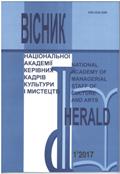SYMBOLIST AND ORCHESTRA-MIMETIC INSTALLATIONS OF MUSICAL CREATIVITY OF THE XX CENTURY IN THE PROJECTION TO PIANISTIC ART
SYMBOLIST AND ORCHESTRA-MIMETIC INSTALLATIONS OF MUSICAL CREATIVITY OF THE XX CENTURY IN THE PROJECTION TO PIANISTIC ART
Author(s): Dariia Volodymyrivna AndrosovaSubject(s): Music, Semiology, Cultural Anthropology / Ethnology
Published by: Національна академія керівних кадрів культури і мистецтв
Keywords: symbolism; orchestral piano imitation; clavier type piano play; art of piano playing;
Summary/Abstract: Purpose of Article. The purpose of the research is to prove natural character of "clavierization" of piano playing in contrast to orchestral theatricality of Liszt’s academic tradition by focusing on aestheticism of symbolistic ("neo-symbolic") tradition of pianistic art, "reconciling" the opposition of the confrontation and the traditionalism of the 1920s – 1970s. Methodology. The methodology of the study consists of such methods as comparative, logical, method of interpretation and historical and analytical generalization, which in combination with the intonation approach (B. Asafiev) have created the basis of comparative, cultural and art-criticism approach for solutions of musical-hermeneutic characteristic of piano art transformation in XX century. Scientific novelty. The scientific novelty consists in independence of theoretical idea of stylistic music autonomy among the art directions of XX century and piano performing art as its musical component. Conclusions. By the end of the twentieth century there was approved the interpretation line of the piano, declared in pre-symbolic – symbolic period of the modern style formation and which turned out to be deeply radical in transforming the piano technique. It caused some new instrument design solutions in general (power to the timbre trans-formations that correlate with the organ). Thus, experience of pianistic creativity opposed clavier radicalism in relation to the classical piano orchestra-"piano wires", in comparison with which "drum" coming from the practice of jazz piano, implemented in piano technique is very weak antithesis of pianistic tradition as a primitivistic "simplification". In the case of "clavierization" we are entering a new level of performance of complex motor-timbre qualities of sound, which does not exclude the traditional orchestrality – but absorbs it as one of the manifestations of the clavierization.
Journal: Вісник Національної академії керівних кадрів культури і мистецтв
- Issue Year: 2017
- Issue No: 1
- Page Range: 57-62
- Page Count: 6
- Language: English

